Chuck Ceraso's lineage traces back to the French and American impressionists through his teacher, Henry Hensche. Hensche was the student and protégé of Charles Hawthorne. Hawthorne, after painting with William Merritt Chase and Claude Monet, started the first art school, in 1900, devoted to the color discoveries of the impressionists. When Hawthorne died in 1930, he left the school and teaching to Hensche, who continued and further developed the teaching until his death in 1992. One of several people around the country who continues to teach this approach to color seeing, Ceraso teaches at the Denver Art Museum, the Art Students League Denver and at his gallery and studio in Lafayette, Colorado. He has recently completed the booklet, The Art of Color Seeing, which is his description of the process Hensche introduced him to as well as his own insights into painting.
DAM: Who is your favorite artist featured in Modern Masters and why?
Chuck Ceraso: I’m most interested in Van Gogh. I find his work more alive than any other artist past or present that I’ve seen. By alive, I mean that the work conveys a presence of energy that goes far beyond picture-making and brings me to the actual place or subject he was painting. I feel he’s not telling me about the subject by showing me a picture of it, but rather, he’s bringing me right up to it, making me present with it and with his amazing intensity of passion. I’ve always noticed how so many paintings seem like pictures that are a step removed from the reality of the subject, but with Van Gogh this isn't the case. If anything, he brings his subjects to greater life, greater reality.
DAM: What is your personal artwork like?
Ceraso: In my work, I strive to capture that level of liveliness by using color in a more sculptural way than a painting one. That is, I seek to convey the light, three-dimensional form and atmosphere by placing shapes of color next to each other as I observe them. I find the visual sensation can be more accurately reproduced in paint when I get both the shapes and color relationships as accurate as I can. I paint most often with the palette knife as I find this more in harmony with this mindset of sculpting. With it I’m able to more easily mold not only the specific shape, but also the specific color of that shape in relation to all the other specific shapes and colors of my subject. In that I can find these color harmonies that light produces in nature.
I guess I could say that light is the main subject in my work, then secondarily, the objects. My subject is first and foremost, the visual sensation itself, removed from any concept I may have about the subject. I strive to remove my preconceptions and stand in front of my subject with full attention to the actual sensation of the light coming into my eyes.
I only work from life, not because I think it's wrong to work from photos, but because I find it easier to step into the reality of the subject when it's right there before me. I’m not interested in reproducing a photographic effect as I find that that’s not at all close to what I experience in real life.
DAM: How does Van Gogh influence you and your work today?
Ceraso: Van Gogh’s passion, not only for painting but for finding a greater truth in expression and his continued process of experimentation with different ways of applying paint, continue to inspire me. All great artists have this, but somehow Van Gogh’s work and life strike something in me more strongly than most others. He seemed to be reaching for something so intangible, ineffable, that one can only ultimately fail at attaining it. It is my goal to fail as superbly as Vincent.
Update: Some of the images referred to in this blog post have been removed following the close of Modern Masters at the Denver Art Museum. Please visit the Albright-Knox Art Gallery website to find the related artworks. This appeared on this post while the exhibition was open:
Vincent Van Gogh, The Old Mill, 1888. Oil on canvas; 25 1/2 x 21 1/4 in. Collection Albright-Knox Art Gallery, Buffalo, NY. Bequest of A. Conger Goodyear, 1966.
Image Credit: Chuck Ceraso, Still Life With Bowl, oil, 12x16 inches.
Chuck Ceraso, Morning Light, oil, 12x16 inches.


